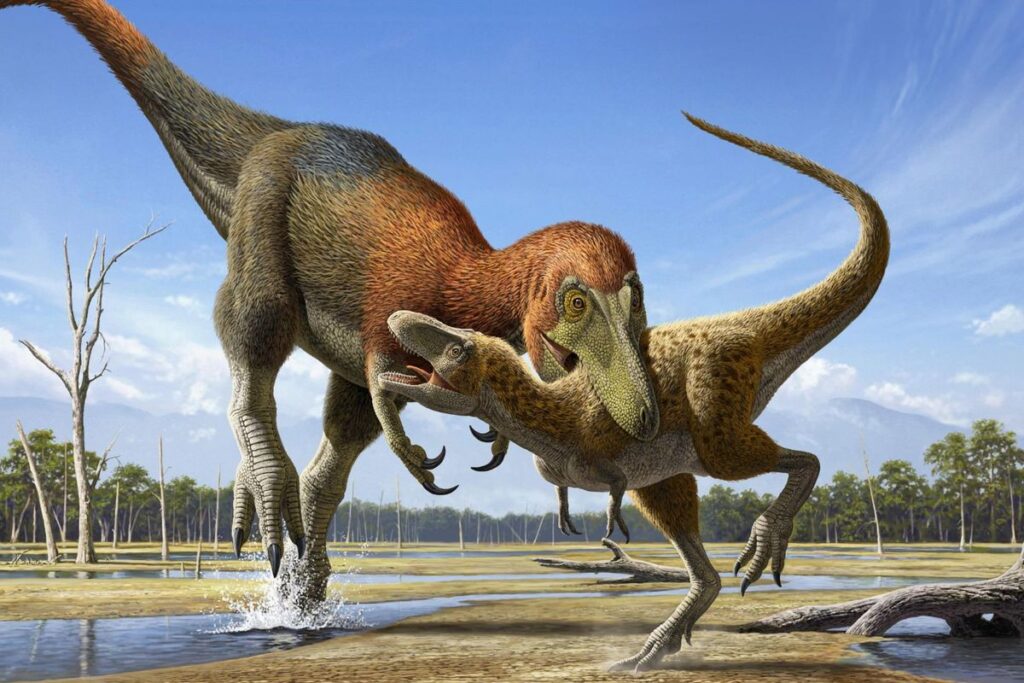A team of paleontologists has confirmed that Nanotyrannus, a small and agile tyrannosaur, was a distinct species and not a juvenile of the . The study, published in , used growth rings, anatomy, and a newly identified fossil of a young T. rex to settle the long-standing debate.
Nanotyrannus, which means “dwarf tyrant,” was first discovered in Montana in 1942. However, its status as a separate species has been controversial, as some scientists argued that it was just a young T. rex that had not yet reached its full size and shape.
To test this hypothesis, the fossils were re-examined by Dr. Nick Longrich from the Milner Centre for Evolution at the University of Bath (UK) and Dr. Evan Saitta from the University of Chicago (USA).
They conducted a thorough analysis of growth rings, the anatomy of Nanotyrannus, and a newly discovered fossil of a young T. rex that was previously unidentified. They found that Nanotyrannus had different features from T.
rex, such as narrower jaws, longer legs, and bigger arms. They also showed that Nanotyrannus was not growing fast but had reached its adult size of about 900-1500 kilograms and five meters – only 15 percent of the size of the giant T. rex, which could weigh up to 8,000 kilograms and measure nine meters or more.
The researchers said they were surprised by how clear the results were. They said that if Nanotyrannus was a young T. rex, it should have been growing rapidly, adding hundreds of kilograms a year, but they did not see that.
They said they tried different ways to model the data but always needed higher growth rates. They said this ended the idea that Nanotyrannus is a young T. rex.
The researchers also found no evidence of fossils with features of both Nanotyrannus and T. rex, which would be expected if they were the same species. Instead, every fossil they studied could be assigned to one species or the other.
Moreover, the researchers discovered a previously overlooked fossil of a young T. rex stored in a museum in San Francisco. The fossil, a skull bone called the frontal bone, had distinctive features that matched T.
rex but not Nanotyrannus. It belonged to a small animal with a skull of about 45 cm long and a body length of around 5 meters. The researchers said this was the first fossil of a young T.
rex that they had. They said it was just one bone, but it was enough. They said T.
rex skull bones were unique; nothing else looked like them. They said young T. rex exist; they are extremely rare, like most dinosaur juveniles.
The researchers argued that these findings were strong evidence that Nanotyrannus was a separate species, one not closely related to Tyrannosaurus. They said it was more lightly built and long-limbed than its thick-set relative. They said it also had larger arms, unlike the famously short-armed T.
rex. “The arms are actually longer than those of T. rex.
Even the biggest T. rex, has shorter arms and smaller claws than in these little Nanotyrannus. This was an animal where the arms were actually pretty formidable weapons.
It’s really just a completely different animal – small, fast, agile. “T. rex relied on size and strength, but this animal relied on speed,” Longrich said.
The researchers said the long arms and other features suggested it was only distantly related to T. rex – and may have sat outside the family Tyrannosauridae, , in its own family of predatory dinosaurs. The new study is the latest in a series of publications on the problem, going back decades.
Longrich said: “Nanotyrannus is highly controversial in paleontology. Not long ago, it seemed like we’d finally settled this problem, and it was a young T. rex.
“I was very skeptical about Nanotyrannus myself until about six years ago when I took a close look at the fossils and was surprised to realize we’d gotten it wrong all these years. ” The researchers propose that the diversity of dinosaurs and other fossil species might be underestimated due to the challenge of distinguishing them based on their frequently incomplete skeletons. As Longrich stated, it is remarkable to consider how much remains unknown about the most renowned dinosaurs, prompting one to question what other misconceptions exist.
.
From: interestingengineering
URL: https://interestingengineering.com/science/fossil-face-off-new-discovery-ends-nanotyrannus-vs-t-rex-debate
